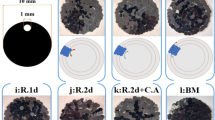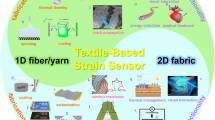Abstract
In the natural world, leaf-cutting ants cause vibrations through their mutual scraping of file-scraper organs. In this study, we designed a Biomimetic Ultrasonic Exciter (BUE) that imitates leaf-cutting ants. The operating characteristics of the BUE were studied through experimental testing and finite element simulations. The results showed that the BUE could generate stable ultrasonic vibrations, and that the excitation frequency only needed to be half the Output Frequency (OF). This frequency-doubling phenomenon was conducive to achieving BUE miniaturization. To further explore the phenomenon of frequency-doubling vibration output, this study designed scrapers of five different sizes, conducted excitation and first-order natural frequency measurement tests, and the corresponding finite element simulations. It was found that each scraper could operate in frequency-doubling mode, but the operating frequency and natural mode frequencies did not correspond with one another. To further explicate experimental and simulation results, a two-degrees-of-freedom vibration model was developed. It was evident that the contact relationship between the dentate disc and scraper introduced strong nonlinear factors into the system, accounting for the frequency-doubling phenomenon and the difference between the BUE’s operating and mode frequencies. The BUE could be expected to facilitate the production of high-power micro-ultrasonic generators and has potential application value in the fields of mechanical processing, industrial production, and medical health.













Similar content being viewed by others
Data Availability
The datasets generated during and/or analyzed during the current study are available from the corresponding author on reasonable request.
References
Yao, Y., Pan, Y., & Liu, S. (2020). Power ultrasound and its applications: A state-of-the-art review. Ultrasonics Sonochemistry, 62, 104722. https://doi.org/10.1016/j.ultsonch.2019.104722
Lu, X., Shen, H., Zhao, K., Wang, Z., Peng, H., & Liu, W. (2019). Micro-/Nanomachines driven by ultrasonic power sources. Chemistry An Asian Journal, 14(14), 2406–2416. https://doi.org/10.1002/asia.201900281
Harvey, G., Gachagan, A., & Mutasa, T. (2014). Review of high-power ultrasound-industrial applications and measurement methods. IEEE Transactions on Ultrasonics, Ferroelectrics, and Frequency Control, 61(3), 481–495. https://doi.org/10.1109/TUFFC.2014.2932
Zhang, X., Peng, Z., & Zhang, D. (2019). Experimental study on a “Snake-Type” vibration cutting method for cutting force and cutting heat reductions. Biomimetics, 4(3), 57. https://doi.org/10.3390/biomimetics4030057
Peng, Z. L., Zhang, X. Y., Liu, L. B., Xu, G. T., Wang, G., & Zhao, M. H. (2023). Effect of high-speed ultrasonic vibration cutting on the microstructure, surface integrity, and wear behavior of titanium alloy. Journal of Materials Research and Technology, 24, 3870–3888. https://doi.org/10.1016/j.jmrt.2023.04.036
Peng, Z. L., Zhang, X. Y., Zhang, Y., Liu, L. B., Xu, G. T., Wang, G., & Zhao, M. H. (2023). Wear resistance enhancement of Inconel 718 via high-speed ultrasonic vibration cutting and associated surface integrity evaluation under high-pressure coolant supply. Wear, 530–531, 205027. https://doi.org/10.1016/j.wear.2023.205027
Zhang, X., Peng, Z., Li, Z., Sui, H., & Zhang, D. (2020). Influences of machining parameters on tool performance when high-speed ultrasonic vibration cutting titanium alloys. Journal of Manufacturing Processes, 60, 188–199. https://doi.org/10.1016/j.jmapro.2020.10.053
Asami, T., & Miura, H. (2015). Study of ultrasonic machining by longitudinal-torsional vibration for processing brittle materials-observation of machining marks. Physics Procedia, 70, 118–121. https://doi.org/10.1016/j.phpro.2015.08.056
Zhou, H., Zhang, J., Yu, D., Feng, P., Wu, Z., & Cai, W. (2019). Advances in rotary ultrasonic machining system for hard and brittle materials. Advances in Mechanical Engineering, 11(12), 1–13. https://doi.org/10.1177/1687814019895929
Ahmed, Y., Cong, W. L., Stanco, M. R., Xu, Z. G., Pei, Z. J., Treadwell, C., Zhu, Y. L., & Li, Z. C. (2012). Rotary ultrasonic machining of alumina dental ceramics: A preliminary experimental study on surface and subsurface damages. Journal of Manufacturing Science and Engineering, 134, 064501. https://doi.org/10.1115/1.4007711
Jiao, L., Tong, Y., Cui, Y., Chen, J., & Bai, Q. Research on ultrasonic cleaning technology of optical components. 7th International Symposium on Advanced Optical Manufacturing and Testing Technologies: Advanced Optical Manufacturing Technologies (vol. 9281, pp. 239–245). Harbin, China. https://doi.org/10.1117/12.2067895 (2014).
Jundt, J. S., Marchena, J. M., Hanna, I., Dhanda, J., Breit, M. J., & Perry, A. P. (2019). Evolving technologies for tissue tutting. Oral and Maxillofacial Surgery Clinics of North America, 31(4), 549–559. https://doi.org/10.1016/j.coms.2019.07.009
Li, J., Dong, X., Zhang, G., Guo, Z., Zhang, G., & Shi, C. (2021). An enhanced hemostatic ultrasonic scalpel based on the longitudinal-torsional vibration mode. IEEE Access, 9, 10951–10961. https://doi.org/10.1109/ACCESS.2021.3050186
Li, J., Liu, H., Li, J., Yang, Y., & Wang, S. (2020). Piezoelectric transducer design for an ultrasonic scalpel with enhanced dexterity for minimally invasive surgical robots. Proceedings of the Institution of Mechanical Engineers, Part C: Journal of Mechanical Engineering Science, 234(7), 1271–1285. https://doi.org/10.1177/0954406219892750
Dai, J. C., Bailey, M. R., Sorensen, M. D., & Harper, J. D. (2019). Innovations in ultrasound technology in the management of kidney stones. Urologic Clinics of North America, 46(2), 273–285. https://doi.org/10.1016/j.ucl.2018.12.009
Mosquera Seoane, L., Ortiz Salvador, J. B., Budia Alba, A., & Perez Fentes, D. A. (2023). Technological innovations in shock wave lithotripsy. Actas Urológicas Españolas (English Edition), 48(1), 105–110. https://doi.org/10.1016/j.acuroe.2023.09.001
Zhang, K., Gao, G., Zhao, C., Wang, Y., Wang, Y., & Li, J. (2023). Review of the design of power ultrasonic generator for piezoelectric transducer. Ultrasonics Sonochemistry, 96, 106438. https://doi.org/10.1016/j.ultsonch.2023.106438
Kazys, R., & Vaskeliene, V. (2021). High temperature ultrasonic transducers: A review. Sensors, 21(9), 3200. https://doi.org/10.3390/s21093200
Li, Y., Huang, W., & Wang, B. (2022). Design and output characteristics of ultrasonic transducer based on rare-earth giant magnetostrictive material. IEEE Transactions on Magnetics, 58(2), 1–6. https://doi.org/10.1109/TMAG.2021.3080691
Li, P., Liu, Q., Zhou, X., Xu, G., Li, W., Wang, Q., & Yang, M. (2021). Effect of Terfenol-D rod structure on vibration performance of giant magnetostrictive ultrasonic transducer. Journal of Vibration and Control, 27(5–6), 573–581. https://doi.org/10.1177/1077546320932029
Clark, A. U. (2002). The role of ultrasonic whistles for degassing liquids. The University of Manchester.
Gallego-Juárez, J. A., Rodríguez, G., Riera, E., & Cardoni, A. (2015). Power ultrasonics (pp. 793–814). Woodhead Publishing. https://doi.org/10.1016/B978-1-78242-33028-6.00026-0
Qiao, F., Roces, F., Schilling, C., & Wurmus, H. Cutting with flexible ultrasound transmission for minimally invasive surgery with biological inspiration. 8th international Conference on New Actuators, Bremen, pp. 668–671 (2002).
Kurosawa, M., & Umehara, Y. (2012). A micro ultrasonic scalpel with modified stepped horn. Electronics and Communications in Japan, 95(8), 44–51. https://doi.org/10.1002/ecj.10414
Friedrich, F., Lockhart, R., Briand, D., Isarakorn, D., Margairaz, P., Sandoz, J.-P., Brossard, J., Keppner, H., Olson, W., Dietz, T., de Rooij, N. F., & Burger, J. Silicon micromachined ultrasonic transducer with improved power transfer for cutting applications. 2012 IEEE International Ultrasonics Symposium, Dresden, pp. 1169–1172. https://doi.org/10.1109/ULTSYM.2012.0291 (2012).
Hofmann, M., Haeberlin, A., de Brot, S., Stahel, A., Keppner, H., & Burger, J. (2023). Development and evaluation of a titanium-based planar ultrasonic scalpel for precision surgery. Ultrasonics, 130, 106927. https://doi.org/10.1016/j.ultras.2023.106927
Kuang, Y., Sadiq, M., Cochran, S., & Huang, Z. (2015). High-power characterization of a microcutter actuated by PMN-PT piezocrystals. IEEE Transactions on Ultrasonics, Ferroelectrics, and Frequency Control, 62(11), 1957–1967. https://doi.org/10.1109/TUFFC.2015.007300
Mckusick, V. A., & Kenneth, W. H. (1959). Félix Savart (1791–1841), physician-physicist: Early studies pertinent to the understanding of murmurs. Journal of the History of Medicine and Allied Sciences, XIV(10), 411–423. https://doi.org/10.1093/jhmas/XIV.10.411
Masters, W. M., Tautz, J., Fletcher, N. H., et al. (1983). Body vibration and sound production in an insect (Atta sexdens) without specialized radiating structures. Journal of Comparative Physiology, 150(2), 239–249. https://doi.org/10.1007/BF00606374
Tautz, J., Roces, F., & Hölldobler, B. (1995). Use of a sound-based vibratome by leaf-cutting ants. Science, 267(5194), 84–87. https://doi.org/10.1126/science.267.5194.84
Markl, H. (1968). Die verständigung durch stridulationssignale bei blattschneiderameisen, II: Erzeugung und eigenschaften der signale. Zeitschrift Für Vergleichende Physiologie, 69(1), 6–37.
Yao, G., Feng, L., Zhang, D., & Jiang, X. (2018). Morphology and mechanical properties of vibratory organs in the leaf-cutting ant (Atta cephalotes). Journal of Bionic Engineering, 15(4), 722–730. https://doi.org/10.1007/s42235-018-0060-6
Schofield, R. M. S., Emmett, K. D., Niedbala, J. C., & Nesson, M. H. (2011). Leaf-cutter ants with worn mandibles cut half as fast, spend twice the energy, and tend to carry instead of cut. Behavioral Ecology and Sociobiology, 65(5), 969–982. https://doi.org/10.1007/s00265-010-1098-6
Schmitz, T. L., & Smith, K. S. (2021). Measurement techniques (pp. 255–282). Springer International Publishing. https://doi.org/10.1007/978-3-030-52344-2_7
Cunha, J., Foltête, E., & Bouhaddi, N. (2008). Evaluation of stiffness of semi-rigid joints in pultruded profiles from dynamic and static data by using model updating technique. Engineering Structures, 30(4), 1024–1036. https://doi.org/10.1016/j.engstruct.2007.06.012
Yang, T., Fan, S.-H., & Lin, C.-S. (2003). Joint stiffness identification using FRF measurements. Computers and Structures, 81(28), 2549–2556. https://doi.org/10.1016/S0045-7949(03)00328-6
Natsiavas, S. (1990). On the dynamics of oscillators with bi-linear damping and stiffness. International Journal of Non-Linear Mechanics, 25(5), 535–554. https://doi.org/10.1016/0020-7462(90)90017-4
Shaw, S. W., & Holmes, P. J. (1983). A periodically forced piecewise linear oscillator. Journal of Sound and Vibration, 90(1), 129–155. https://doi.org/10.1016/0022-460X(83)90407-8
Wong, C. W., Zhang, W. S., & Lau, S. L. (1991). Periodic forced vibration of unsymmetrical piecewise-linear systems by incremental harmonic balance method. Journal of Sound and Vibration, 149(1), 91–105. https://doi.org/10.1016/0022-460X(91)90913-5
Acknowledgements
This work was supported by the National Natural Science Foundation of China (grant nos. 91960203, 51975035)
Author information
Authors and Affiliations
Corresponding author
Ethics declarations
Conflict of Interest
The authors declare that they have no known competing financial interests or personal relationships that could have appeared to influence the work reported in this paper.
Additional information
Publisher's Note
Springer Nature remains neutral with regard to jurisdictional claims in published maps and institutional affiliations.
Rights and permissions
Springer Nature or its licensor (e.g. a society or other partner) holds exclusive rights to this article under a publishing agreement with the author(s) or other rightsholder(s); author self-archiving of the accepted manuscript version of this article is solely governed by the terms of such publishing agreement and applicable law.
About this article
Cite this article
Wu, W., Zhang, M., Li, Z. et al. Bioinspired Scraper-File Type Frequency-Doubling Ultrasonic Exciter. J Bionic Eng (2024). https://doi.org/10.1007/s42235-024-00518-2
Received:
Revised:
Accepted:
Published:
DOI: https://doi.org/10.1007/s42235-024-00518-2




